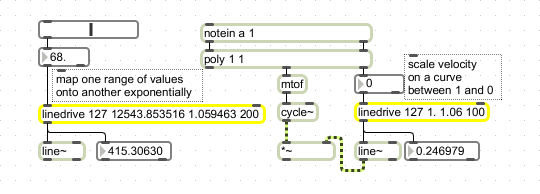Examples

Use linedrive for exponential value scaling
Scale numbers exponentially
| Name | Type | Opt | Description |
|---|---|---|---|
| maximum-input maximum-output scaling-curve | int or float | Obligatory. The first argument is the maximum input value, followed by the maximum output value. The third argument specifies the nature of the scaling curve. The third argument must be greater than 1. The larger the value, the more steeply exponential the curve is. An appropriate value for this argument is 1.06. The fourth argument is the initial delay time in milliseconds. This value can be changed via the right inlet. |
| int | input-to-conversion [int] |
In left inlet: The number is converted according to the following expression y = b e^{-a log c} e^{x log c} where x is the input, y is the output, a, b, and c are the three typed-in arguments, and e is the base of the natural logarithm (approximately 2.718282). The output is a two-item list containing y followed by the delay time most recently received in the right inlet. |
| (inlet1) | delay-time [int] |
In right inlet: Sets the current delay time appended to the scaled output. A connected line~ object will ramp to the new target value over this time interval. |
| float | input-to-conversion [float] |
In left inlet: The number is converted according to the following expression y = b e^{-a log c} e^{x log c} where x is the input, y is the output, a, b, and c are the three typed-in arguments, and e is the base of the natural logarithm (approximately 2.718282). The output is a two-item list containing y followed by the delay time most recently received in the right inlet. |
